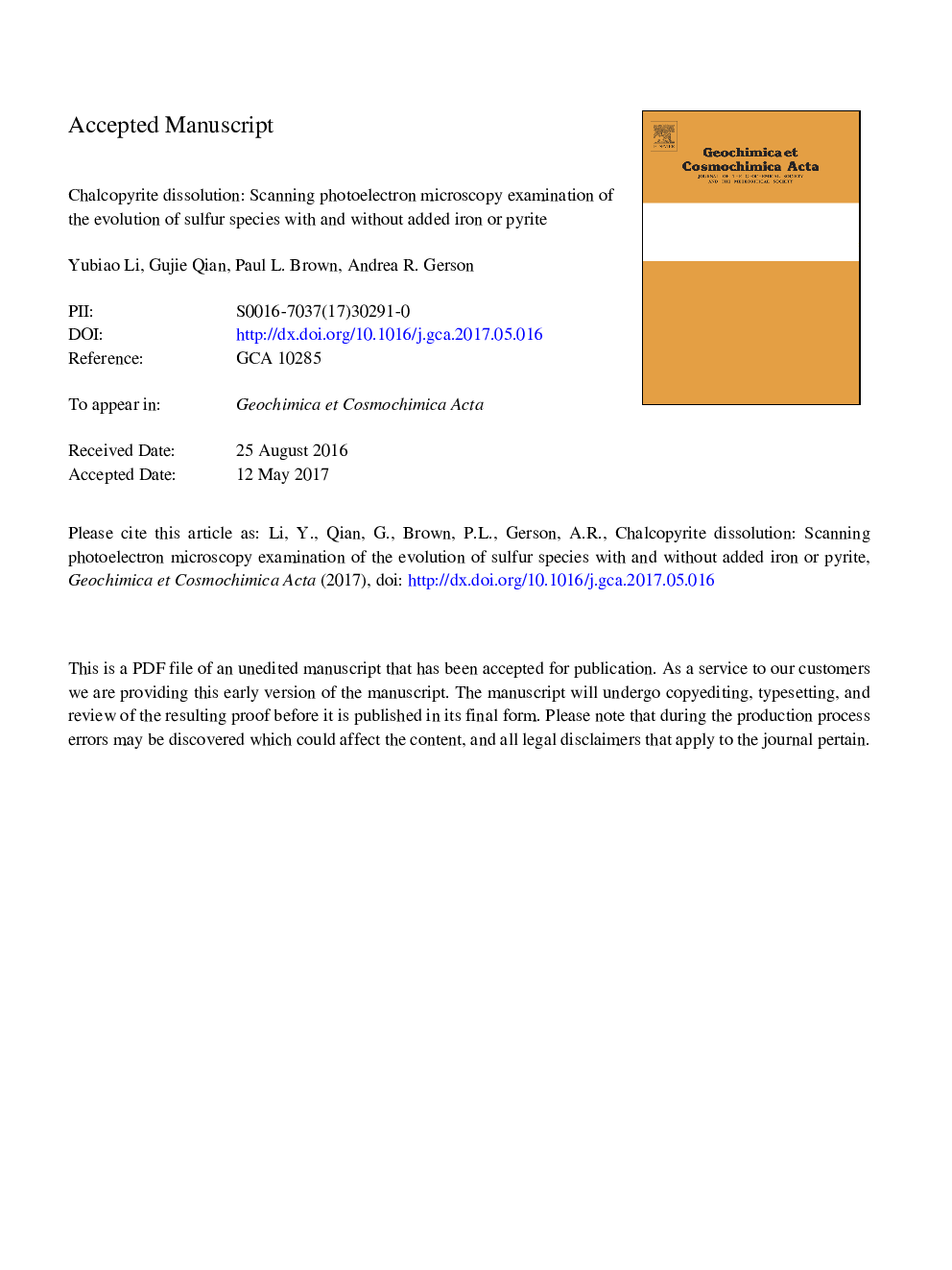| کد مقاله | کد نشریه | سال انتشار | مقاله انگلیسی | نسخه تمام متن |
|---|---|---|---|---|
| 5783165 | 1637945 | 2017 | 37 صفحه PDF | دانلود رایگان |
عنوان انگلیسی مقاله ISI
Chalcopyrite dissolution: Scanning photoelectron microscopy examination of the evolution of sulfur species with and without added iron or pyrite
ترجمه فارسی عنوان
انحلال چالکوپیریت: بررسی میکروسکوپ الکترونی الکترونی از تکامل انواع گوگرد با و بدون افزودن آهن یا پیریت
دانلود مقاله + سفارش ترجمه
دانلود مقاله ISI انگلیسی
رایگان برای ایرانیان
کلمات کلیدی
موضوعات مرتبط
مهندسی و علوم پایه
علوم زمین و سیارات
ژئوشیمی و پترولوژی
چکیده انگلیسی
Dissolution and oxidation of sulfide minerals play key roles in both acid and metalliferous rock drainage and supergene enrichment. Surface speciation heterogeneity, critical to understanding mechanisms of mineral sulfide dissolution, has to date largely not been considered. To this end synchrotron scanning photoelectron microscopy (SPEM) was employed to examine freshly fractured and partially dissolved chalcopyrite (CuFeS2) surfaces (pH 1.0 HClO4 solution, redox potential 650 mV relative to a standard hydrogen electrode, 75 °C). S2â (bulk), S22â and Sn2â were found to be present on all samples at varying concentrations. Oxidation was observed to take place heterogeneously at the sub-micron scale. As compared to chalcopyrite partially dissolved for 5 days, extended dissolution to 10 days did not show appreciably enhanced oxidation of surface species; however surface roughness increased markedly due to the growth/overlap of oxidised sulfur species. On addition of 4 mM iron both S0 and SO42â were observed but not SO32â, indicating that the greater Fe3+ activity/concentration promotes heterogeneous sulfur oxidation. On contact of pyrite (FeS2) with chalcopyrite, significantly greater chalcopyrite surface oxidation was observed than for the other systems examined, with S0, SO32â and SO42â being identified heterogeneously across the surface. It is proposed that chalcopyrite oxidative dissolution is enhanced by increasing its cathodic area, e.g. contacting with pyrite, while increased Fe3+ activity/concentration also contributes to increased dissolution rates. The high degree of surface heterogeneity of these surface products indicates that these surfaces are not passivated by their formation. These results suggest that chalcopyrite dissolution will be accelerated when in contact with pyrite at solution redox potential intermediate between the rest potentials of chalcopyrite and pyrite (560 mV and 660 mV, respectively) and/or iron rich acidic waters with resulting enhanced formation of secondary sulfur containing species and release of copper and iron. This in turn suggests accelerated supergene formation and enhanced metalliferous drainage under these conditions.
ناشر
Database: Elsevier - ScienceDirect (ساینس دایرکت)
Journal: Geochimica et Cosmochimica Acta - Volume 212, 1 September 2017, Pages 33-47
Journal: Geochimica et Cosmochimica Acta - Volume 212, 1 September 2017, Pages 33-47
نویسندگان
Yubiao Li, Gujie Qian, Paul L. Brown, Andrea R. Gerson,
